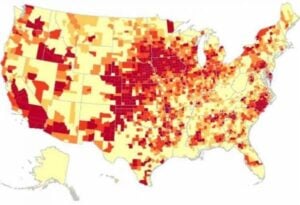Map Reveals Massive Increase in Factory Farming

If you haven’t seen it yet, Food & Water Watch launched an incredible updated version of its online Factory Farm Map. Users are able to view the locations and drastically increased numbers of factory farms between 1997 and 2007. Sort by cattle, dairy cows, pigs, broiler and layer chickens, or view them all at once to see the massive impact factory farming has on our country’s landscape.
A 20 percent spike in the total number of animals living on factory farms in the last five years brings the tally to nearly 2 billion chickens, pigs and cows living in unspeakable conditions, very possibly just down the road from you. Within those categories, some have doubled their growth, like cows on dairy farms. And how about this: “The growth of industrial broiler chicken production added 5,800 chickens every hour over the past decade.” Someone needs to lay off the nuggets for a while.
Those little splotches of color on the map actually represent six times as many animals as people in this country and where there are factory farms, there are health risks to all of us. Be it environmental damage to the air, water and soil, the risk of food borne illnesses often as a direct result of the high levels of filth and contamination in factory farms, or the risks of contracting bacteria resistant illnesses due to the overuse of antibiotics in factory farmed animals, clearly you don’t have to be vegan to feel icky about the rapidly increasing number of factory farms.
While the site can be pretty depressing, there’s an amazing tool everyone should know about that you can link to from the Food & Water Watch Website. When you go to the search function and type in your zip code, it pulls up a list of local area farmers, bakers and CSA programs (community supported agriculture) that are likely to provide factory-farm free options. It’s thorough too, for my area 398 listings came up from coffee shops to co-ops, education centers and even personal chefs. Though you may think your little purchase is a drop in the bucket, every bit makes a difference.
Stay in touch with Jill on Twitter: www.twitter.com/jillettinger
Photo Courtesy of Food & Water Watch

